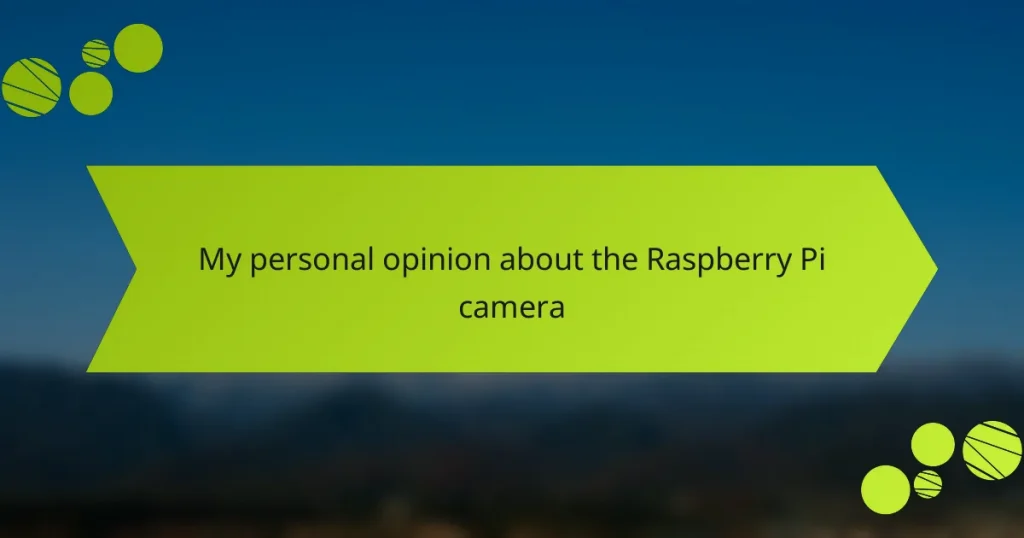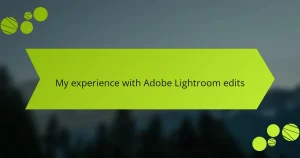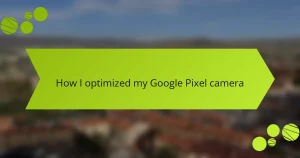Key takeaways
- The Raspberry Pi camera is a versatile, compact device ideal for DIY projects and creative experimentation, offering good image and video quality.
- It connects easily to various Raspberry Pi models, enhancing functionality for projects like time-lapse photography and home surveillance.
- While budget-friendly, the camera has limitations in low-light performance and a narrow field of view, making it less suitable for certain conditions.
- It serves as a great learning tool, providing hands-on experience with programming and electronics while being cost-effective compared to traditional cameras.
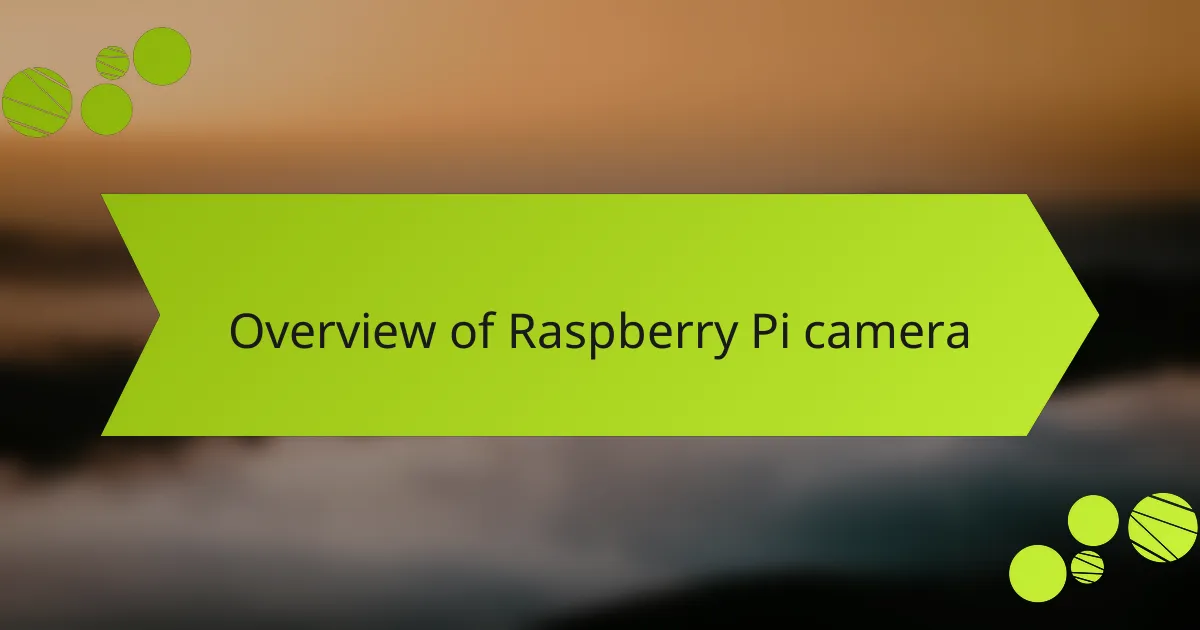
Overview of Raspberry Pi camera
The Raspberry Pi camera is a fascinating little device that transforms the Raspberry Pi into a powerful tool for photography and video. I remember the excitement I felt when I first connected it to my Raspberry Pi; it was like unlocking a whole new dimension of creativity. With its compact size and impressive capabilities, it’s perfect for DIY projects, whether you’re a hobbyist or just looking to learn something new.
What really stands out to me is the versatility of the Raspberry Pi camera. It can be used for anything from time-lapse photography to video streaming. Have you ever wondered how you could capture your garden blooming over the seasons? With this camera, you can easily set up a project like that, and it truly brings a sense of satisfaction.
Additionally, the quality of the images and videos is surprisingly good for such a small device. I recall experimenting with it for a home surveillance setup, and I was pleased with the clarity and detail. It’s amazing how technology like this can make video projects feel accessible, even for those of us who aren’t professional photographers.
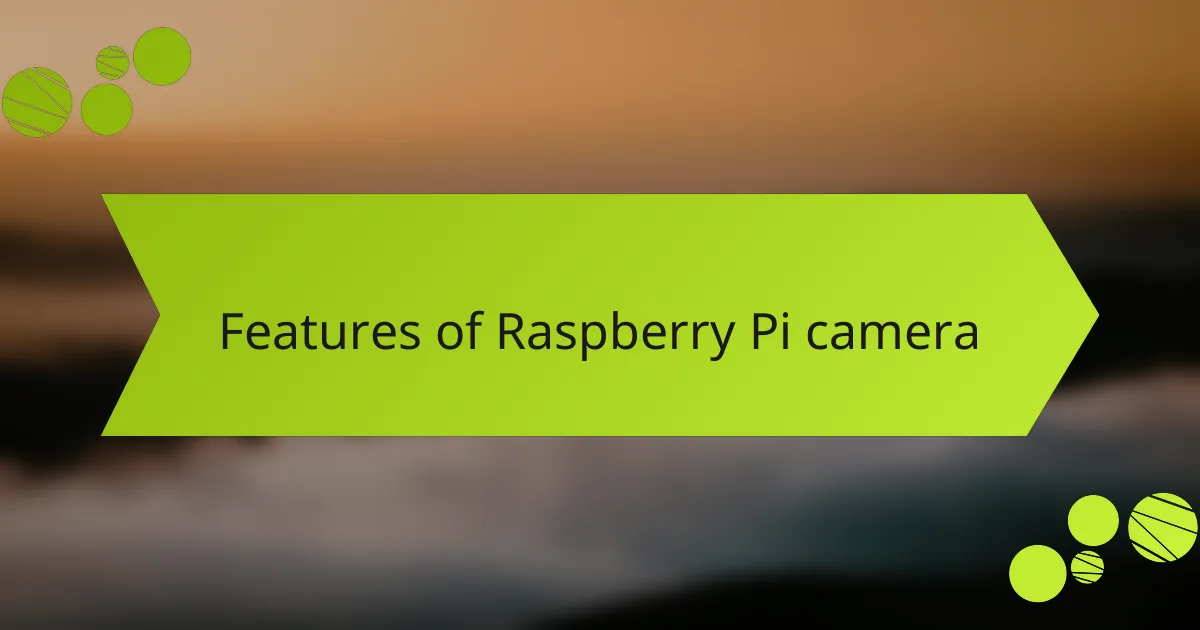
Features of Raspberry Pi camera
The Raspberry Pi camera is a versatile little device that packs a punch for its size. With features like a 5-megapixel sensor, it captures surprisingly clear images and videos, making it great for projects ranging from home surveillance to simple photography experiments. Personally, I’ve enjoyed using it to document my DIY projects; watching the process come to life through the lens added a whole new dimension to my creations.
The ability to interface with various Raspberry Pi models is another standout feature. It can easily connect to a Pi board using a dedicated camera interface, which not only simplifies setup but also enhances functionality. I remember the first time I connected it; it was thrilling to see my ideas take shape within minutes.
Explore the specifications in the comparison table below to understand the capabilities of different Raspberry Pi camera modules:
| Feature | Raspberry Pi Camera v1.3 | Raspberry Pi Camera v2.1 |
|---|---|---|
| Sensor | 5 MP | 8 MP |
| Video Resolution | 1080p at 30fps | 1080p at 30fps |
| Field of View | 50 degrees | 62.2 degrees |
| Low Light Performance | Average | Improved |
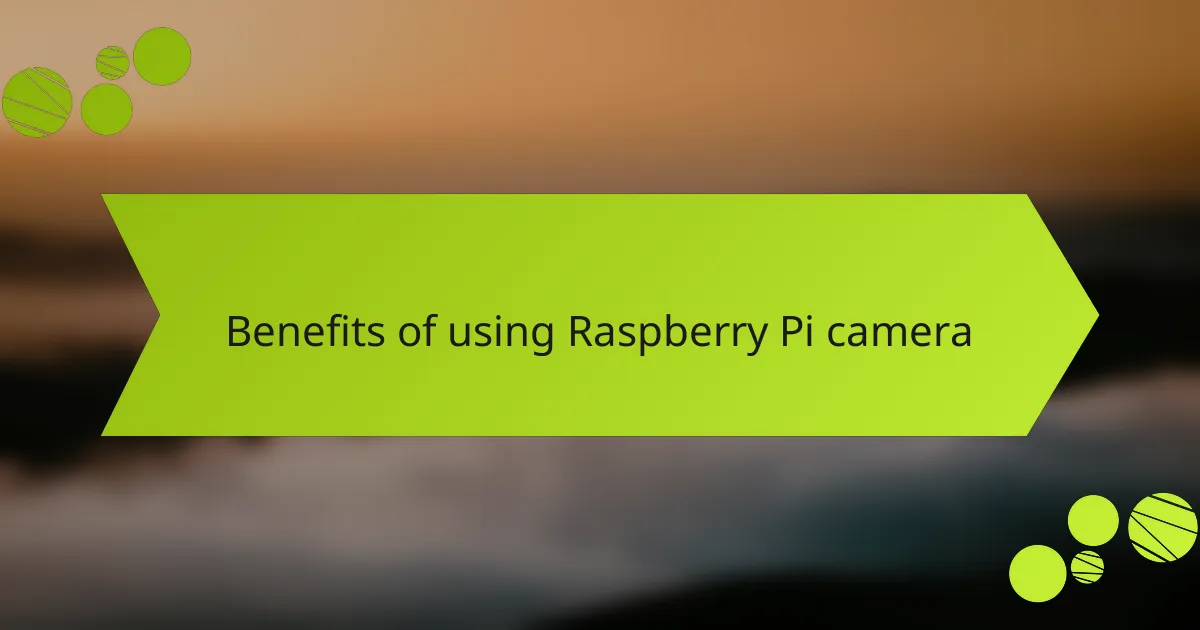
Benefits of using Raspberry Pi camera
The Raspberry Pi camera offers fantastic versatility for hobbyists and professionals alike. One major benefit is its compact size, making it easy to integrate into various projects without taking up much space. From my experience, I’ve found that the ability to connect it to the Raspberry Pi opens up a world of possibilities for creative experimentation, such as DIY security cameras and time-lapse photography.
Another compelling advantage is affordability. Compared to traditional cameras, the Raspberry Pi camera is budget-friendly, which allows anyone to start exploring the world of photography without breaking the bank. I’ve personally used it for a home automation project, capturing images for monitoring purposes, and it was immensely satisfying to see how effective and cost-efficient it was.
Here’s a comparison table that highlights some key features of the Raspberry Pi camera versus standard cameras:
| Feature | Raspberry Pi Camera | Standard Camera |
|---|---|---|
| Size | Compact and lightweight | Larger and bulkier |
| Price | Inexpensive | Can be quite expensive |
| Integration | Great for DIY projects | Limited integration options |
| Flexibility | Highly customizable | Less customizable |
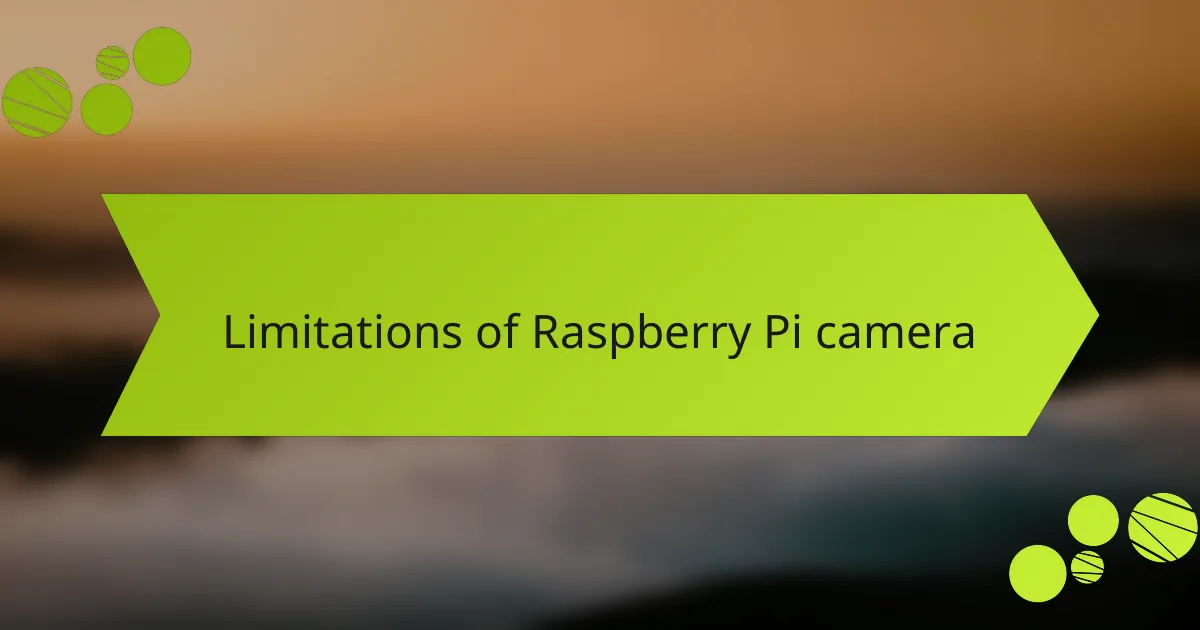
Limitations of Raspberry Pi camera
When it comes to the limitations of the Raspberry Pi camera, I must admit it’s a mixed bag for me. While it’s a fantastic tool for hobbyists and educators, its lack of low-light performance can be a deal-breaker. I’ve tried using it for nighttime projects, and I found the images somewhat grainy, which can be frustrating when you’re aiming for clarity.
Another limitation I’ve encountered is its narrow field of view. I remember setting it up for a wider shot, only to realize it captures a much smaller area than I expected. This can be limiting for certain projects where a more expansive view is essential. Lastly, the absence of advanced settings means that fine-tuning can be a hassle, especially for those who want to push the camera’s capabilities to the max.
| Limitation | Details |
|---|---|
| Low-light performance | Images can appear grainy in dim lighting. |
| Narrow field of view | Captures a smaller area than some might expect. |
| Limited settings | Lacks advanced features for fine-tuning the shot. |
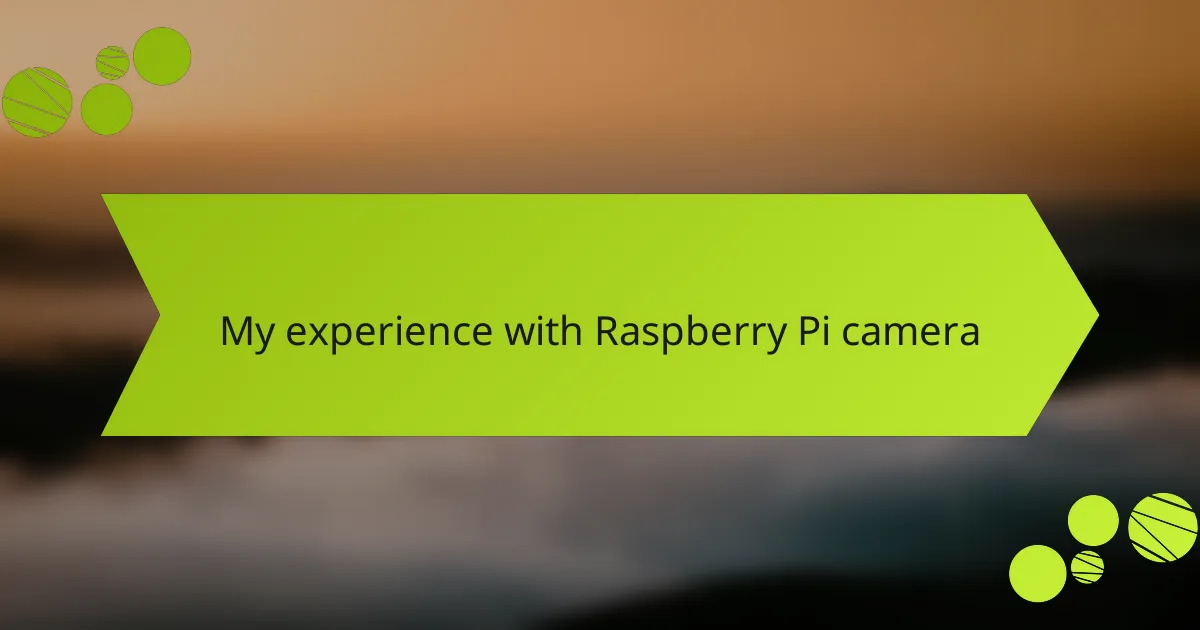
My experience with Raspberry Pi camera
My experience with the Raspberry Pi camera has been quite exciting and enlightening. When I first got my hands on it, I was thrilled to experiment with all the creative possibilities. The clarity of the images surprised me, especially for such a compact device. I vividly remember setting it up for a time-lapse project in my garden. Watching the flowers bloom over days captured was not just rewarding but also a testament to the camera’s performance.
However, I did face challenges while trying to use the camera in low-light conditions. The noise level was noticeable, which made me rethink how and where I used it. Still, my overall journey with the Raspberry Pi camera has been enriching, allowing me to learn, tinker, and push the boundaries of what’s possible with a small, affordable device.
| Feature | Raspberry Pi Camera |
|---|---|
| Image Quality | High resolution, decent clarity |
| Low Light Performance | Limited, noticeable noise |
| Ease of Use | Simple setup, versatile software options |
| Price | A budget-friendly option |
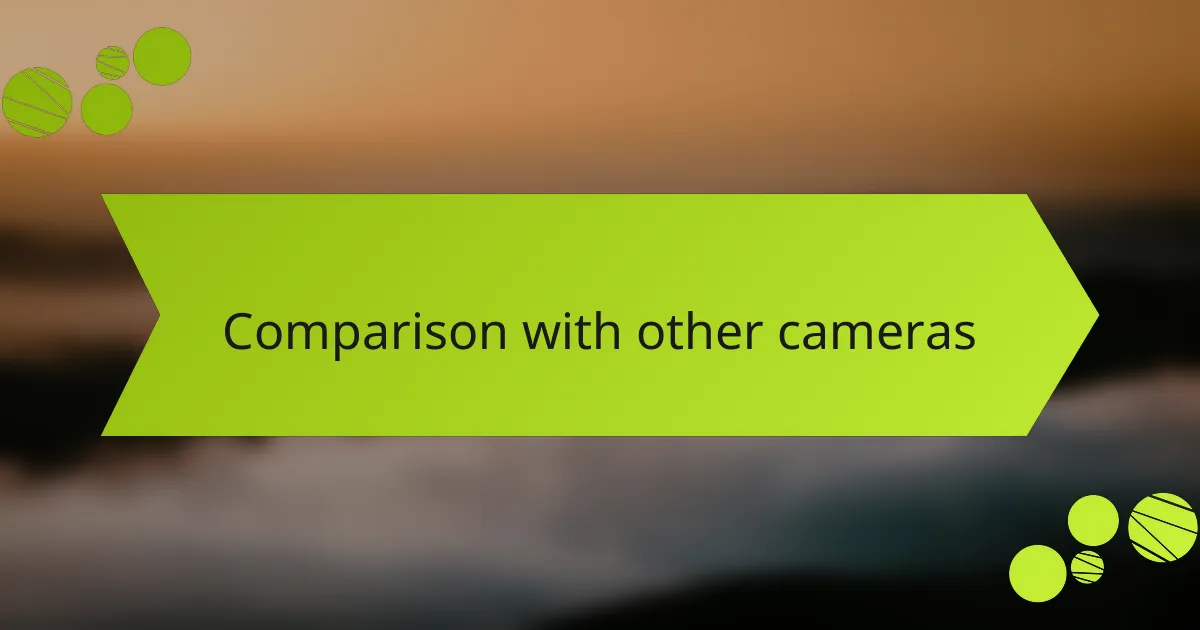
Comparison with other cameras
When I first began experimenting with cameras, I was intrigued by how the Raspberry Pi camera stacked up against more traditional models. Although it may not boast the same robust features as DSLRs or mirrorless cameras, the affordability and flexibility of the Raspberry Pi camera drew me in. I remember setting it up for a home automation project rather than just photography, and I realized that its strength lies in creativity and integration rather than raw image quality.
In my experience, the Raspberry Pi camera excels in specific use cases, particularly for DIY projects and educational purposes. Here’s a quick comparison of the Raspberry Pi camera against other common camera types:
- Cost: Raspberry Pi camera is significantly cheaper, allowing more people to explore photography and tech without breaking the bank.
- Customization: The Raspberry Pi camera can be easily integrated into various projects, unlike typical cameras which often come with limited adaptability.
- Size: It’s compact and lightweight, making it easy to install in various setups or to use in tight spaces where larger cameras simply won’t fit.
- Image Quality: While it offers decent quality for casual shots, it may lag behind in precision compared to higher-end cameras.
- Learning Curve: Using a Raspberry Pi camera can be an excellent gateway to learning programming and electronics, providing a hands-on approach that traditional cameras don’t offer.
Overall, the choice really depends on what you’re hoping to achieve. If you’re looking for a fun project or a new way to explore photography, the Raspberry Pi camera could be the perfect starting point.
